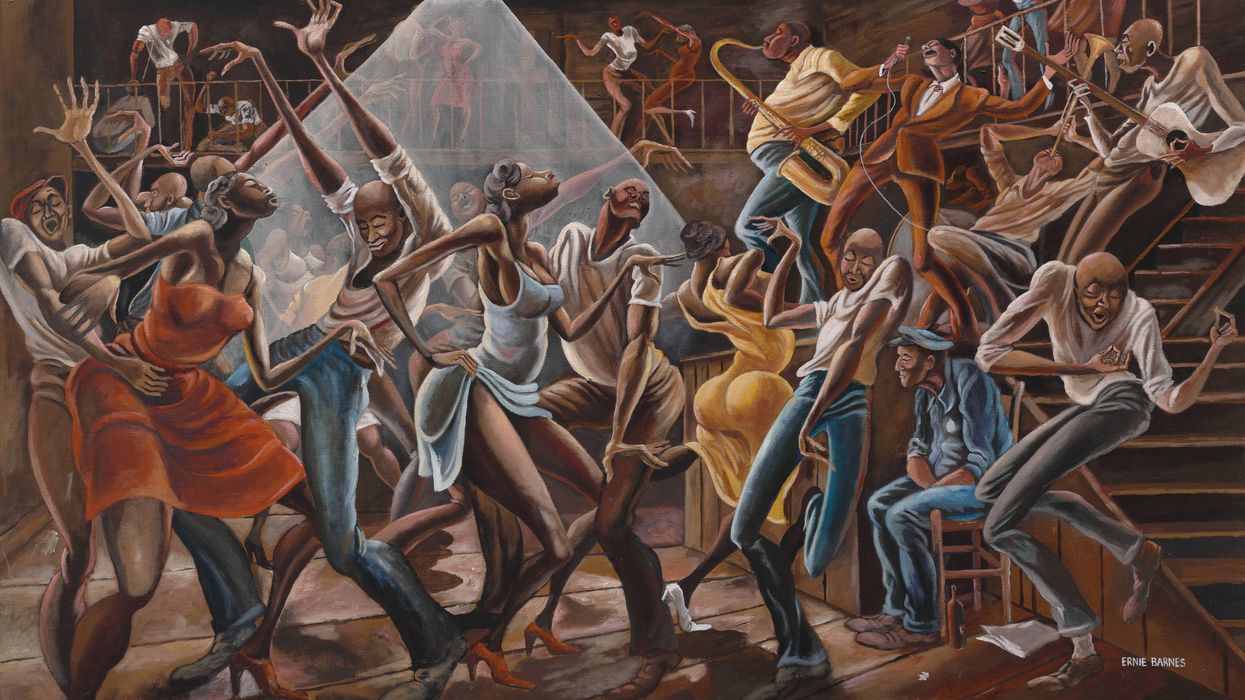Iconic ‘Sugar Shack’ Painting on View at MFAH Through the End of the Year

ONE NEED NOT be a child of the ’70s to hear music, sweet music, when looking at Ernie Barnes’ 1976 painting “The Sugar Shack,” on view June 15 through Dec. 31 at the Museum of Fine Arts, Houston.
The compositionally complex, rhythmically charged work is a feast for the eyes, conveying the wonder and fear of the artist as a young boy, and his memory of sneaking into a local dance hall in Durham, N.C., during the years of Jim Crow laws and segregation, and seeing for the first time how the grown-ups got their groove on and released the tensions of the day. This being painted from memory, it’s interesting to note that every figure in The Sugar Shack has their eyes closed, as if experiencing a collective state of Dionysian ecstasy. It’s hard to think of another painting so connected to the sound of its time.
Born July 15, 1938, Barnes was a chubby, introverted kid who listened to classical music and loved to draw. He would go on to become a professional football player before eventually making the transition into a career as a full-time artist. The painting on view at the MFAH is actually the second version of a painting by Barnes. The first one was used as the cover of Marvin Gaye’s classic album I Want You. The banners hanging at the top of the painting reference the album’s songs, including “After the Dance” and the majestic title track. Gaye dug the piece and hung onto it, so Barnes produced a second version in 1976.
The new version appeared during the opening and closing credits of the 1970s sitcom Good Times, alluding to the artistic aspirations of the character J.J. Evans, played by comedian Jimmie Walker. It also made headlines when Houston collector and energy trader Bill Perkins purchased it at Christie’s 20th Century auction last month for a whopping $15.3 million. Perkins loaned it to the MFAH through the end of the year.
Throughout the 1970s and ’80s, Barnes provided artwork for several other bands, including Houston’s own jazz fusion pioneers The Crusaders, who used his painting Head Over Heels for the cover of their 1986 album The Good and Bad Times.
Given these Houston connections, and an expansive body of work celebrating the joy of black music, spirituality and athleticism, can an Ernie Barnes retrospective at the MFAH be far behind?


The iconic painting as it appeared on Marvin Gaye's album cover
- From Obama to Optical Illusions: Ambitious Spring Season Awaits at ... ›
- MFAH's New 'Culinary Canvas' Series Is a Feast for the Eyes and ... ›
- Tabled So Curators Could Add ‘Perspectives’ Following George Floyd's Murder, this Poignant Show Is Up at MFAH - Houston CityBook ›
- MFAH Installs Two Provocative Paintings in its Foyer, Presenting Them Together as a 'Portrait of Courage' - Houston CityBook ›
- Ernie Barnes Stole the Show at Christie's With His $15.3 Million ... ›
- Ernie Barnes Retrospective Brings Renewed Attention to African ... ›
- Why Ernie Barnes' 'Sugar Shack' has museum-goers lined up in L.A. ... ›
- Ernie Barnes's 'Sugar Shack' Painting Brings Big Price at Auction ... ›
- The Museum of Fine Arts, Houston: Home ›











